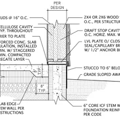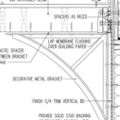Air-barrier details
We are planning a pretty-good-house, with a target blower-door test of 2.0 ACH @ 50 Pa. We will have Zip-R1.5 sheathing on the walls and use low-density foam to obtain the roof air barrier.
GBA has plenty of good info on wall and roof design, but I could use some help with issues in detailing:
1) Bathroom and kitchen venting: What is the best set-up for “air-tighting” the 4″ exhaust ducts?
2) Dryer vent (for a gas-fired conventional clothes dryer; a condensing dryer is not an option): What is the best set-up for “air-tighting” these 4″ exhaust ducts?
GBA Detail Library
A collection of one thousand construction details organized by climate and house part










Replies
Mark,
Q. "Bathroom and kitchen venting: What is the best set-up for “air-tighting” the 4 inch exhaust ducts?"
A. A bathroom exhaust fan is usually located in your bathroom ceiling. Typically, the air barrier in this room is the ceiling drywall. As long as you include caulk or a gasket between the ceiling drywall and the exhaust fan housing, you have a ceiling air barrier.
For more information on this issue, see these two articles:
"Bathroom Exhaust Fans"
"Air Sealing an Attic"
Q. "Dryer vent (for a gas-fired conventional clothes dryer; a condensing dryer is not an option): What is the best set-up for “air-tighting” these 4-inch exhaust ducts?"
A. Choose an exterior termination with a good backdraft damper. Here is a link to one commercial product:
https://www.truevalue.com/dryer-vent-seal-4-in?ctplacement=271426-43411605579&cid=gooshop
You'll be using galvanized ductwork to vent your clothes dryer. Use a high-quality caulk to seal the crack where the duct penetrates your air barrier.